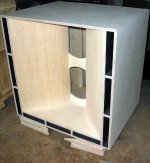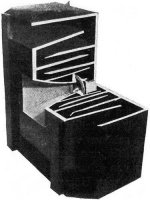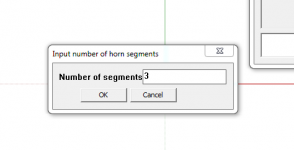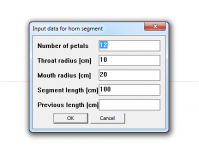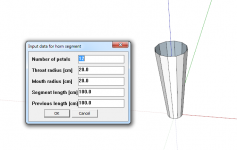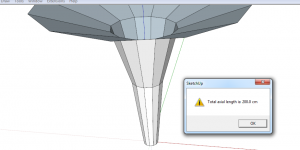Hi Oliver, BP1Fanatic and zettairyouiki,
Thanks for the feedback, it seems that the consensus is that the value of Vrc should change when the width changes.
Q3. I was not going to apply the process to the second horn in a compound horn system. The values of S5 and S6 sliders will not change when the width slider is altered. Do you agree with this approach?
Kind regards,
David
Thanks for the feedback, it seems that the consensus is that the value of Vrc should change when the width changes.
Q3. I was not going to apply the process to the second horn in a compound horn system. The values of S5 and S6 sliders will not change when the width slider is altered. Do you agree with this approach?
Kind regards,
David
Not sure. I've always thought of CH as a pretty niche case compared to TH and FLH so I don't really have an opinion.
Hi David,
I see the compound horn as a specialty case, e.g.: the front horn, rear bass reflex, and I don't think they need a width slider function? I'll attach a picture of an example.
But, maybe somebody would use CH for a 1/4 wave simulation? I know I have used them for BP6, and then a width function might be interesting, as it would affect both volumes, and both ports. I have also miss-used it for H-frame dipoles.
So, maybe yes, it could come in handy every now and then, as long as it would not affect anything while set at its nominal (center?) value.
Regards,
I see the compound horn as a specialty case, e.g.: the front horn, rear bass reflex, and I don't think they need a width slider function? I'll attach a picture of an example.
But, maybe somebody would use CH for a 1/4 wave simulation? I know I have used them for BP6, and then a width function might be interesting, as it would affect both volumes, and both ports. I have also miss-used it for H-frame dipoles.
So, maybe yes, it could come in handy every now and then, as long as it would not affect anything while set at its nominal (center?) value.
Regards,
Attachments
Last edited:
Hi BP1Fanatic,
I wish. 🙂 This pictures came from artec-france.com. I don't know if you can still find these Onkens there? There are similar enclosures from all the great old companies, like Altec, etc..
Regards,
I wish. 🙂 This pictures came from artec-france.com. I don't know if you can still find these Onkens there? There are similar enclosures from all the great old companies, like Altec, etc..
Regards,
Hi zettairyouiki, BP1Fanatic and Oliver,
Again, thanks for your comments.
After giving it some more thought, because the second horn in a conventional compound horn system is unlikely to have parallel sides, it is probably better not to have S5 and S6 change as the width slider changes.
It is currently proposed to link S1, S2, S3, S4, S5 (not CH) and Vrc to the width slider.
With Vrc included, it means that it will also be possible to vary the width of a direct radiator system enclosure using the width slider.
Not sure how long it will take to work through the coding / testing required to implement the new feature.
Attached is a photo of a compound horn loudspeaker developed by Olson and Massa in the mid 1930's. The single diaphragm is coupled to two horns - a straight-axis high-frequency horn (specified in Hornresp using S5, S6 and L56) and a folded low-frequency horn.
Kind regards,
David
Again, thanks for your comments.
After giving it some more thought, because the second horn in a conventional compound horn system is unlikely to have parallel sides, it is probably better not to have S5 and S6 change as the width slider changes.
It is currently proposed to link S1, S2, S3, S4, S5 (not CH) and Vrc to the width slider.
With Vrc included, it means that it will also be possible to vary the width of a direct radiator system enclosure using the width slider.
Not sure how long it will take to work through the coding / testing required to implement the new feature.
Attached is a photo of a compound horn loudspeaker developed by Olson and Massa in the mid 1930's. The single diaphragm is coupled to two horns - a straight-axis high-frequency horn (specified in Hornresp using S5, S6 and L56) and a folded low-frequency horn.
Kind regards,
David
Attachments
Hi David,
That will be a nice and worthwhile addition to Hornresp. Also, nice compound horn example.
Regards,
That will be a nice and worthwhile addition to Hornresp. Also, nice compound horn example.
Regards,
Visualize your petal horn designed in Hornresp
Hi
I have made a small plugin for Sketchup, where you can create a basic drawing of a multi segment conical petal horn.
When you have exported your design to a .csv file then the numbers can be plugged into the plugin.
In the first window you type in the number of conical segments, default is three. Then you type in the data for each segment. It will use the values from the previous step, so the mouth radius of the previous step is now the throat radius in the next.
There are no obvious limitations to the number of segments or petals other than what Sketchup can handle, so with enough patience you can make that wildly curved horn 😀
Hi
I have made a small plugin for Sketchup, where you can create a basic drawing of a multi segment conical petal horn.
When you have exported your design to a .csv file then the numbers can be plugged into the plugin.
In the first window you type in the number of conical segments, default is three. Then you type in the data for each segment. It will use the values from the previous step, so the mouth radius of the previous step is now the throat radius in the next.
There are no obvious limitations to the number of segments or petals other than what Sketchup can handle, so with enough patience you can make that wildly curved horn 😀
Attachments
I have made a small plugin for Sketchup, where you can create a basic drawing of a multi segment conical petal horn.
Hi Daniel,
Thanks for sharing.
Kind regards,
David
@ David McBean
Re post 5667
That mid 1930's Olson and Massa horn was way ahead of it's time !
I don't what it sounded like, but to achieve what they did Without a computer/software & the test equipment available since then, is remarkable 🙂
Thanx for posting 😉
Re post 5667
That mid 1930's Olson and Massa horn was way ahead of it's time !
I don't what it sounded like, but to achieve what they did Without a computer/software & the test equipment available since then, is remarkable 🙂
Thanx for posting 😉
@ David McBean
Re post 5667
That mid 1930's Olson and Massa horn was way ahead of it's time !
I don't what it sounded like, but to achieve what they did Without a computer/software & the test equipment available since then, is remarkable 🙂
Thanx for posting 😉
Hi Zero D,
I suspect that it would have sounded surprisingly good. Harry Olson and Frank Massa really knew what they were doing, even though they only had slide rules and manual tabulating machines to help with crunching the numbers.
Kind regards,
David
Hello David McBean, I'm new here in the forum, I want to congratulate for his beautiful work involving hornresp, I'm giving my first steps in hornesp, I have some questions and doubts in choosing the best parameter of speakers to be optimized in type boxes tapped horn, found in a research that the Fs of the driver used may actually be higher (1.414x) the court that you're looking for, this gives? as the qts and bl how best band you recommend? these are my questions and I thank if you can help me.
Hello David McBean, I'm new here in the forum, I want to congratulate for his beautiful work involving hornresp, I'm giving my first steps in hornesp, I have some questions and doubts in choosing the best parameter of speakers to be optimized in type boxes tapped horn, found in a research that the Fs of the driver used may actually be higher (1.414x) the court that you're looking for, this gives? as the qts and bl how best band you recommend? these are my questions and I thank if you can help me.
Hi adilson,
Welcome to the Hornresp thread.
As far as the best parameter values for tapped horn drivers are concerned, you are directing your questions to the wrong person 🙂. My practical experience in such matters is very limited indeed. Hopefully someone with more knowledge than I have, will read your post and be able to help you out.
Kind regards,
David
Thank you David for attention, do not know if I was clear in my question, so if you allow me I will do again. thanks
Thank you David for attention, do not know if I was clear in my question, so if you allow me I will do again. thanks
Hi adilson,
I think your question is clear enough, it's just a matter of someone choosing to respond to it 🙂.
Kind regards,
David
No takers?
OK here is a tab at the answer.
If you are interested in producing what many are calling tapped horns, you are looking for a driver with a high sensitivity. High SPL/watt. And a high BL.
If you are going for a true tapped horn you are looking for a driver with those attributes and a higher Fs. This type of a driver can be used to create a tapped horn with more efficiency when compared to the same driver in a vented enclosure.
OK here is a tab at the answer.
If you are interested in producing what many are calling tapped horns, you are looking for a driver with a high sensitivity. High SPL/watt. And a high BL.
If you are going for a true tapped horn you are looking for a driver with those attributes and a higher Fs. This type of a driver can be used to create a tapped horn with more efficiency when compared to the same driver in a vented enclosure.
- Home
- Loudspeakers
- Subwoofers
- Hornresp
